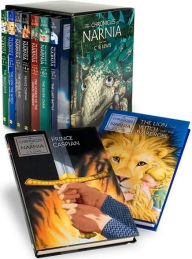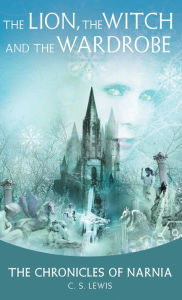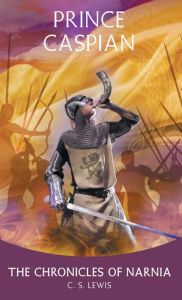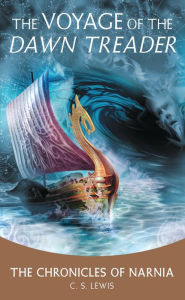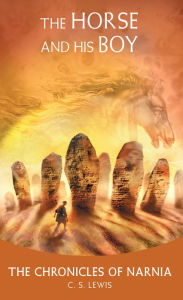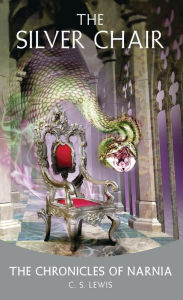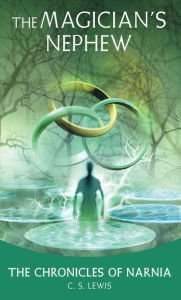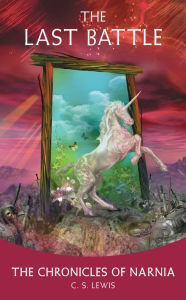9 Things You Never Knew about The Chronicles of Narnia
The Chronicles of Narnia Box Set
The Chronicles of Narnia Box Set
By
C. S. Lewis
Illustrator
Pauline Baynes
In Stock Online
Hardcover $139.63
If you’ve been alive and more or less aware over the last 60-odd years, you are no doubt familiar with C.S. Lewis’ The Chronicles of Narnia. The seven-book series ranks collectively among the most-beloved novels of all time (they’re certainly among the bestselling). In fact, the Narnia books are so embedded in pop culture, you may think you know everything there is to know about them—but even after all these years, and all the film and TV adaptations, these nine facts about the series may still surprise you.
If you’ve been alive and more or less aware over the last 60-odd years, you are no doubt familiar with C.S. Lewis’ The Chronicles of Narnia. The seven-book series ranks collectively among the most-beloved novels of all time (they’re certainly among the bestselling). In fact, the Narnia books are so embedded in pop culture, you may think you know everything there is to know about them—but even after all these years, and all the film and TV adaptations, these nine facts about the series may still surprise you.
The Lion, the Witch and the Wardrobe (Chronicles of Narnia Series #2)
The Lion, the Witch and the Wardrobe (Chronicles of Narnia Series #2)
By
C. S. Lewis
Illustrator
Pauline Baynes
In Stock Online
Paperback $9.99
Lewis came up with the idea when he was 16
Lewis published The Lion, the Witch, and the Wardrobe in 1950, when he was 52 year old, but the original inspiration for the story came when he was just 16: an image of a faun carrying parcels through the snow. He said that after carrying that vision with him for more than 20 years, he sat down one day to try write a story around it—a story it took him him 10 more years to finish.
Lewis came up with the idea when he was 16
Lewis published The Lion, the Witch, and the Wardrobe in 1950, when he was 52 year old, but the original inspiration for the story came when he was just 16: an image of a faun carrying parcels through the snow. He said that after carrying that vision with him for more than 20 years, he sat down one day to try write a story around it—a story it took him him 10 more years to finish.
Prince Caspian (Chronicles of Narnia Series #4)
Prince Caspian (Chronicles of Narnia Series #4)
By
C. S. Lewis
Illustrator
Pauline Baynes
In Stock Online
Paperback $9.99
Lewis burned an early version
Lewis began work on the first book in 1939, and produced a draft in which the children were named Ann, Martin, Rose, and Peter. When he showed the story to his friends and colleagues, however, the reaction was consistently negative, so he burned the manuscript and started over. He later stated that the missing ingredient was Aslan: as soon as he added the heroic and not-at-all tame lion to the story, everything fell into place.
Lewis burned an early version
Lewis began work on the first book in 1939, and produced a draft in which the children were named Ann, Martin, Rose, and Peter. When he showed the story to his friends and colleagues, however, the reaction was consistently negative, so he burned the manuscript and started over. He later stated that the missing ingredient was Aslan: as soon as he added the heroic and not-at-all tame lion to the story, everything fell into place.
The Voyage of the Dawn Treader (Chronicles of Narnia Series #5)
The Voyage of the Dawn Treader (Chronicles of Narnia Series #5)
By
C. S. Lewis
Illustrator
Pauline Baynes
In Stock Online
Paperback $9.99
Turkish Delight is…an acquired taste
]In the first book, when the White Witch Jadis is tempting Edmund, he asks for—and receives, to his greedy delight—a bowl of Turkish Delight. Which means that every year, a fresh crop of children start scheming to get their hands on this obvious delicacy. The truth is, real Turkish Delight is a traditional treat with the consistency of a marshmallow and the taste…well, a taste that is tough to describe. But unless you’re eating one of the watered-down versions drowned in milk chocolate, there is a really good chance you won’t enjoy it.
Turkish Delight is…an acquired taste
]In the first book, when the White Witch Jadis is tempting Edmund, he asks for—and receives, to his greedy delight—a bowl of Turkish Delight. Which means that every year, a fresh crop of children start scheming to get their hands on this obvious delicacy. The truth is, real Turkish Delight is a traditional treat with the consistency of a marshmallow and the taste…well, a taste that is tough to describe. But unless you’re eating one of the watered-down versions drowned in milk chocolate, there is a really good chance you won’t enjoy it.
The Horse and His Boy
The Horse and His Boy
By
C. S. Lewis
Illustrator
Pauline Baynes
In Stock Online
Paperback $9.99
People still argue about the correct order
Lewis was honest about not having planned out the series; he expected to write one book, then wrote a sequel and thought that would be the end of it, and so on. As a result, he stated explicitly that he had no preference for a reading order. The publisher started claiming that Lewis had a “preferred order” that began with The Magician’s Nephew, the sixth book to be published. People still get into internet fights over the subject.
People still argue about the correct order
Lewis was honest about not having planned out the series; he expected to write one book, then wrote a sequel and thought that would be the end of it, and so on. As a result, he stated explicitly that he had no preference for a reading order. The publisher started claiming that Lewis had a “preferred order” that began with The Magician’s Nephew, the sixth book to be published. People still get into internet fights over the subject.
The Silver Chair
The Silver Chair
By
C. S. Lewis
Illustrator
Pauline Baynes
In Stock Online
Paperback $9.99
Susan is the most controversial character in the series
Susan Pevensie, the Gentle Queen, only appears in the first two books. In The Voyage of the Dawn Treader, she’s said to be in America with the Pevensie parents, on a trip. By the time of The Last Battle, when Narnia is destroyed and the Pevensies (and just about everyone else ever connected with Narnia) are transported from the scene of an accident to live forever with Aslan, Susan is specifically left out, because (basically) she’s grown up and left her childhood fantasies behind. Or, if you believe author Philip Pullman and J.K. Rowling, she’s excluded because she’s discovered the joys of sex, which Lewis disapproved of. Susan, in fact, remains the one character that can get Narnia fans into an all-out brawl—is she the victim of Lewis’ hateful misogyny, a silly girl who lost immortality, or can we imagine she would someday be recalled to Narnia?
Susan is the most controversial character in the series
Susan Pevensie, the Gentle Queen, only appears in the first two books. In The Voyage of the Dawn Treader, she’s said to be in America with the Pevensie parents, on a trip. By the time of The Last Battle, when Narnia is destroyed and the Pevensies (and just about everyone else ever connected with Narnia) are transported from the scene of an accident to live forever with Aslan, Susan is specifically left out, because (basically) she’s grown up and left her childhood fantasies behind. Or, if you believe author Philip Pullman and J.K. Rowling, she’s excluded because she’s discovered the joys of sex, which Lewis disapproved of. Susan, in fact, remains the one character that can get Narnia fans into an all-out brawl—is she the victim of Lewis’ hateful misogyny, a silly girl who lost immortality, or can we imagine she would someday be recalled to Narnia?
The Magician's Nephew (Chronicles of Narnia Series #1)
The Magician's Nephew (Chronicles of Narnia Series #1)
By
C. S. Lewis
Illustrator
Pauline Baynes
In Stock Online
Paperback $9.99
Many of the characters are based on real people
Lewis borrowed most of Narnia from other works, legends, and his own religious background. He also borrowed people. The Pevensie children were based on actual children who came to live with Lewis during the Blitz in World War II; Puddleglum the Marsh-Wiggle was based on Lewis’ gardener, Fred Paxford; and Lewis himself can be seen as the basis for Professor Digory Kirke.
Many of the characters are based on real people
Lewis borrowed most of Narnia from other works, legends, and his own religious background. He also borrowed people. The Pevensie children were based on actual children who came to live with Lewis during the Blitz in World War II; Puddleglum the Marsh-Wiggle was based on Lewis’ gardener, Fred Paxford; and Lewis himself can be seen as the basis for Professor Digory Kirke.
The Last Battle
The Last Battle
By
C. S. Lewis
Illustrator
Pauline Baynes
In Stock Online
Paperback $9.99
They’re still making movies
Three major films based on the books were released between 2005 and 2010, but production stalled on a fourth due to declining ticket sales. For a while, it was assumed that either no more movies would be made, or the whole series would be rebooted. However, a fourth film, The Silver Chair is planned for a 2018 release, with an all-new production team and cast.
It isn’t really a Christian allegory
If you know nothing else about the Narnia books, you know that Lewis wrote them as Christian allegory, and you’re either okay with that, or horrified by it. But the fact is, the books aren’t an allegory at all—they’re a thought experiment. While there are definitely Christian references and themes in there, Lewis simply asked himself: suppose there was a world like Narnia—how would God save it as he saved this one?
Who ever heard of a witch that really died?
At the end of The Lion, The Witch, and The Wardrobe, the White Witch—Queen Jadis—is defeated and killed. We meet her again, of course, in The Magician’s Nephew, where her origins in Narnia are revealed. But a lot of people think we also see her in The Silver Chair, as the Lady of the Green Kirtle, who has enslaved Prince Rilian of Narnia. The descriptions of the two women are very close, and as Nikabrik states in Prince Caspian, “who ever heard of a witch that really died?”
They’re still making movies
Three major films based on the books were released between 2005 and 2010, but production stalled on a fourth due to declining ticket sales. For a while, it was assumed that either no more movies would be made, or the whole series would be rebooted. However, a fourth film, The Silver Chair is planned for a 2018 release, with an all-new production team and cast.
It isn’t really a Christian allegory
If you know nothing else about the Narnia books, you know that Lewis wrote them as Christian allegory, and you’re either okay with that, or horrified by it. But the fact is, the books aren’t an allegory at all—they’re a thought experiment. While there are definitely Christian references and themes in there, Lewis simply asked himself: suppose there was a world like Narnia—how would God save it as he saved this one?
Who ever heard of a witch that really died?
At the end of The Lion, The Witch, and The Wardrobe, the White Witch—Queen Jadis—is defeated and killed. We meet her again, of course, in The Magician’s Nephew, where her origins in Narnia are revealed. But a lot of people think we also see her in The Silver Chair, as the Lady of the Green Kirtle, who has enslaved Prince Rilian of Narnia. The descriptions of the two women are very close, and as Nikabrik states in Prince Caspian, “who ever heard of a witch that really died?”
